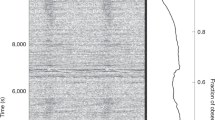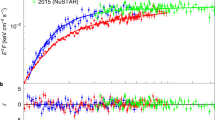Abstract
Millisecond pulsars are neutron stars that attain their very fast rotation during a 108–109-yr-long phase of disk accretion of matter from a low-mass companion star1,2. They can be detected as accretion-powered millisecond X-ray pulsars if towards the end of this phase their magnetic field is strong enough to channel the in-flowing matter towards their magnetic poles3. When mass transfer is reduced or ceases altogether, pulsed emission generated by magnetospheric particle acceleration and powered by the star rotation is observed, preferentially in the radio4 and gamma-ray5 bands. A few transitional millisecond pulsars that swing between an accretion-powered X-ray pulsar regime and a rotationally powered radio pulsar regime in response to variations of the mass in-flow rate have been recently identified6,7. Here, we report the detection of optical pulsations from a transitional millisecond pulsar. The pulsations were observed when the pulsar was surrounded by an accretion disk, and originated inside the magnetosphere or within a few hundreds of kilometres from it. Energy arguments rule out reprocessing of accretion-powered X-ray emission and argue against a process related to accretion onto the pulsar polar caps; synchrotron emission of electrons in a rotation-powered pulsar magnetosphere8 seems more likely.
This is a preview of subscription content, access via your institution
Access options
Access Nature and 54 other Nature Portfolio journals
Get Nature+, our best-value online-access subscription
$29.99 / 30 days
cancel any time
Subscribe to this journal
Receive 12 digital issues and online access to articles
$119.00 per year
only $9.92 per issue
Buy this article
- Purchase on Springer Link
- Instant access to full article PDF
Prices may be subject to local taxes which are calculated during checkout



Similar content being viewed by others
References
Alpar, M. A., Cheng, A. F., Ruderman, M. A. & Shaham, J. A new class of radio pulsars. Nature 300, 728–730 (1982).
Radhakrishnan, V. & Srinivasan, G. On the origin of the recently discovered ultra-rapid pulsar. Curr. Sci. India 51, 1096–1099 (1982).
Wijnands, R. & van der Klis, M. A millisecond pulsar in an X-ray binary system. Nature 394, 344–346 (1998).
Backer, D. C., Kulkarni, S. R., Heiles, C., Davis, M. M. & Goss, W. M. A millisecond pulsar. Nature 300, 615–618 (1982).
Abdo, A. A. et al. A population of gamma-ray millisecond pulsars seen with the Fermi Large Area Telescope. Science 325, 848–852 (2009).
Archibald, A. M. et al. A radio pulsar/X-ray binary link. Science 324, 1411–1414 (2009).
Papitto, A. et al. Swings between rotation and accretion power in a binary millisecond pulsar. Nature 501, 517–520 (2013).
Cocke, W. J., Disney, M. J. & Taylor, D. J. Discovery of optical signals from pulsar NP 0532. Nature 221, 525–527 (1969).
Deller, A. T. et al. A parallax distance and mass estimate for the transitional millisecond pulsar system J1023+0038. Astrophys. J. Lett. 756, L25 (2012).
Stappers, B. W. et al. A state change in the missing link binary pulsar system PSR J1023+0038. Astrophys. J. 790, 39 (2014).
Patruno, A. et al. A new accretion disk around the missing link binary system PSR J1023+0038. Astrophys. J. Lett. 781, L3 (2014).
Tendulkar, S. P. et al. NuSTAR observations of the state transition of millisecond pulsar binary PSR J1023+0038. Astrophys. J. 791, 77 (2014).
Archibald, A. M. et al. Accretion-powered pulsations in an apparently quiescent neutron star binary. Astrophys. J. 807, 62 (2015).
Bogdanov, S. et al. Coordinated X-ray, ultraviolet, optical, and radio observations of the PSR J1023+0038 system in a low-mass X-ray binary state. Astrophys. J. 806, 148 (2015).
Papitto, A. & Torres, D. F. A propeller model for the sub-luminous state of the transitional millisecond pulsar PSR J1023+0038. Astrophys. J. 807, 33 (2015).
Deller, A. T. et al. Radio imaging observations of PSR J1023+0038 in an LMXB state. Astrophys. J. 809, 13 (2015).
Takata, J. et al. Multi-wavelength emissions from the millisecond pulsar binary PSR J1023+0038 during an accretion active state. Astrophys. J. 785, 131 (2014).
Coti Zelati, F. et al. Engulfing a radio pulsar: the case of PSR J1023+0038. Mon. Not. R. Astron. Soc. 444, 1783–1792 (2014).
Shahbaz, T. et al. The binary millisecond pulsar PSR J1023+0038 during its accretion state—I. Optical variability. Mon. Not. R. Astron. Soc. 453, 3461–3473 (2015).
Jaodand, A. et al. Timing observations of PSR J1023+0038 during a low-mass X-ray binary state. Astrophys. J. 830, 122 (2016).
Davidsen, A., Henry, J. P., Middleditch, J. & Smith, H. E. Identification of the X-ray pulsar in Hercules: a new optical pulsar. Astrophys. J. Lett. 177, L97–L102 (1972).
Papitto, A. et al. X-ray coherent pulsations during a sub-luminous accretion disc state of the transitional millisecond pulsar XSS J12270-4859. Mon. Not. R. Astron. Soc. 449, L26–L30 (2015).
Gierliński, M., Done, C. & Barret, D. Phase-resolved X-ray spectroscopy of the millisecond pulsar SAX J1808.4-3658. Mon. Not. R. Astron. Soc. 331, 141–153 (2002).
Frank, J., King, A. & Raine, D. J. Accretion Power in Astrophysics 3rd edn (Cambridge Univ. Press, Cambridge, 2002).
Romanova, M. M., Ustyugova, G. V., Koldoba, A. V. & Lovelace, R. V. E. Three-dimensional simulations of disk accretion to an inclined dipole. II. Hot spots and variability. Astrophys. J. 610, 920–932 (2004).
Pacini, F. & Salvati, M. The optical luminosity of very fast pulsars. Astrophys. J. 274, 369–371 (1983).
Romani, R. W. Gamma-ray pulsars: radiation processes in the outer magnetosphere. Astrophys. J. 470, 469 (1996).
Mignani, R. P. Optical, ultraviolet, and infrared observations of isolated neutron stars. Adv. Space. Res. 47, 1281–1293 (2011).
Strader, M. J. et al. Search for optical pulsations in PSR J0337+1715. Mon. Not. R. Astron. Soc. 459, 427–430 (2016).
Rangelov, B. et al. Hubble Space Telescope detection of the millisecond pulsar J2124-3358 and its far-ultraviolet bow shock nebula. Astrophys. J. 835, 264 (2017).
Mignani, R. P., Pavlov, G. G. & Kargaltsev, O. A possible optical counterpart to the old nearby pulsar J0108-1431. Astron. Astrophys. 488, 1027–1030 (2008).
Papitto, A., Torres, D. F. & Li, J. A propeller scenario for the gamma-ray emission of low-mass X-ray binaries: the case of XSS J12270-4859. Mon. Not. R. Astron. Soc. 438, 2105–2116 (2014).
Barbieri, C. et al. Status of the Galileo National Telescope. In Proc. SPIE Vol. 2199 (ed. Stepp, L. M.) 10–21 (SPIE, 1994).
Zappacosta, L. et al. Constraining the thermal history of the warm-hot intergalactic medium. Astron. Astrophys. 434, 801–809 (2005).
Meddi, F. et al. A new fast silicon photomultiplier photometer. Publ. Astron. Soc. Pac. 124, 448–453 (2012).
Ambrosino, F. et al. The latest version of SiFAP: beyond microsecond time scale photometry of variable objects. J. Astron. Instrum. 5, 16500051267 (2016).
Leahy, D. A., Elsner, R. F. & Weisskopf, M. C. On searches for periodic pulsed emission—the Rayleigh test compared to epoch folding. Astrophys. J. 272, 256–258 (1983).
Leahy, D. A. Searches for pulsed emission—improved determination of period and amplitude from epoch folding for sinusoidal signals. Astron. Astrophys. 180, 275–277 (1987).
Deeter, J. E., Boynton, P. E. & Pravdo, S. H. Pulse-timing observations of Hercules X-1. Astrophys. J. 247, 1003–1012 (1981).
Papitto, A. et al. Spin down during quiescence of the fastest known accretion-powered pulsar. Astron. Astrophys. 528, A55 (2011).
Gehrels, N. et al. The Swift Gamma-Ray Burst Mission. Astrophys. J. 611, 1005–1020 (2004).
Burrows, D. N. et al. The Swift X-Ray Telescope. Space. Sci. Rev. 120, 165–195 (2005).
Roming, P. W. A. et al. The Swift Ultra-Violet/Optical Telescope. Space. Sci. Rev. 120, 95–142 (2005).
Manchester, R. N., Hobbs, G. B., Teoh, A. & Hobbs, M. The Australia Telescope National Facility pulsar catalogue. Astron. J. 129, 1993–2006 (2005).
Acknowledgements
F.A., P.C. and F.M. acknowledge the research project Protocol C26A15YCJ4 funded by the Department of Physics of the University of Rome (La Sapienza), for the financial support. A.P. acknowledges funding from the European Union’s Horizon 2020 Framework Programme for Research and Innovation under the Marie Skłodowska-Curie Individual Fellowship grant agreement 660657-TMSP-H2020-MSCA-IF-2014, and wishes to thank D. de Martino, N. Rea and D. F. Torres for useful discussions. L.B., T.D.S. and A.P. acknowledge fruitful discussion with the international team on ‘The disk–magnetosphere interaction around transitional millisecond pulsars at the International Space Science Institute (ISSI), Bern. L.B., T.D.S., G.L.I. and L.S. acknowledge financial contribution from the agreement ASI-INAF I/037/12/0. Results obtained and presented in this paper are based on observations made with the Italian Telescopio Nazionale Galileo (TNG) operated on the island of La Palma by the Fundación Galileo Galilei of the INAF (Istituto Nazionale di Astrofisica) at the Spanish Observatorio del Roque de los Muchachos of the Instituto de Astrofisica de Canarias. The authors gratefully acknowledge time Discretionary Observing Time granted by the TNG Director, E. Molinari and thank C. Rossi for her scientific support and contribution.
Author information
Authors and Affiliations
Contributions
F.A. and A.P. jointly coordinated and contributed equally to this study. F.M., F.A. and P.C. conceived and designed the optical photometer. F.A., A.G., L.D.F. and L.R. performed the optical observations. A.P. and F.A. analysed the data. A.P. and L.S. wrote the paper. A.P., L.S., T.D.S. and L.B. interpreted the results. All authors read, commented on and approved submission of this article.
Corresponding author
Ethics declarations
Competing interests
The authors declare no competing financial interests.
Additional information
Publisher’s note: Springer Nature remains neutral with regard to jurisdictional claims in published maps and institutional affiliations.
Electronic supplementary material
Supplementary Information
Supplementary Figures 1–4, Supplementary Tables 1–2 and Supplementary References
Rights and permissions
About this article
Cite this article
Ambrosino, F., Papitto, A., Stella, L. et al. Optical pulsations from a transitional millisecond pulsar. Nat Astron 1, 854–858 (2017). https://doi.org/10.1038/s41550-017-0266-2
Received:
Accepted:
Published:
Issue Date:
DOI: https://doi.org/10.1038/s41550-017-0266-2
This article is cited by
-
Optical and ultraviolet pulsed emission from an accreting millisecond pulsar
Nature Astronomy (2021)
-
High plasma cut-off frequency blocks the radio emission from accreting millisecond X-ray pulsar SAX J1808.4-3658
Astrophysics and Space Science (2020)
-
Stunningly bright optical emission
Nature Astronomy (2017)



